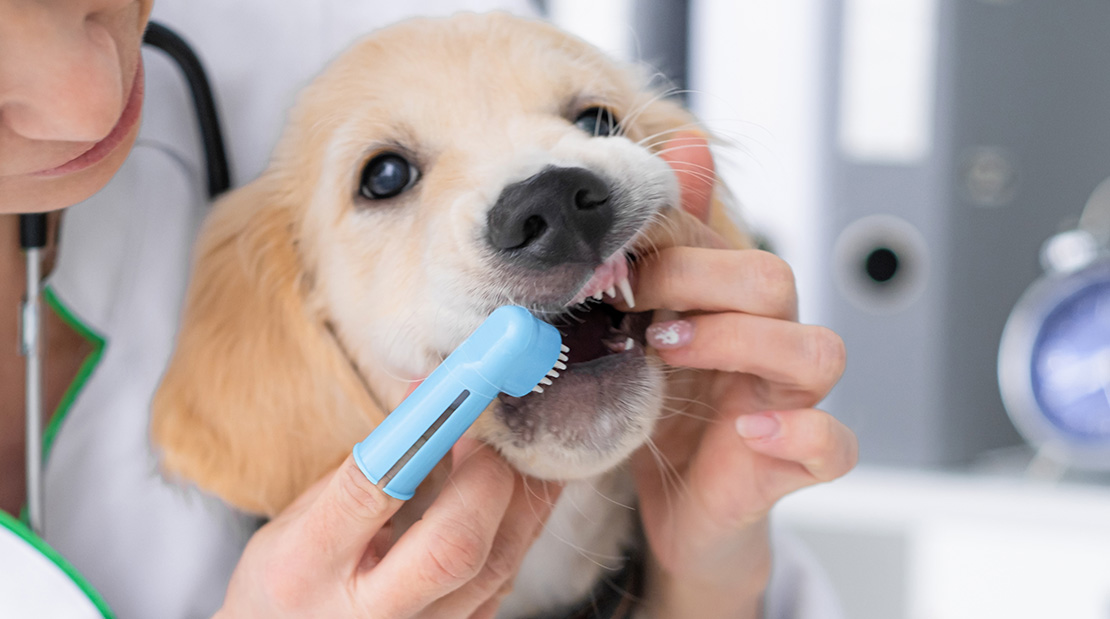
How to Take Care of Puppy Teeth
Having a new puppy is exciting and fun! Your new companion adds energy, reduces stress, and comes with a lot of added responsibility including, but not limited to, dental care.
Signs of a teething puppy?
There are some common signs when puppies are teething, but it’s important to keep in mind each dog is different. So, they may show all, some, or none of the signs below.
- Increased saliva
- An aversion to hard foods
- Small amounts of blood as they lose their deciduous (baby teeth)
- Crying or whining as their adult teeth come in
You can help ease their discomfort by offering soft foods, teething toys, and by puppy-proofing your home.
Why does my puppy chew everything?
Teething puppies chew to scratch or relieve pressure inside their mouths. As a pet owner, allowing them to chew on things will encourage their baby teeth to fall out. However, you don’t want them to chew on inedible things. When puppies swallow things not meant for consumption, it can lead to an obstruction in their digestive tract. You can redirect your puppy’s teething behavior by giving them pet toys and treats to chew on.
How many teeth will my dog lose?
Puppies are born without teeth. Typically, teeth start to develop between 2 and 4 weeks old. At around 5 months old, puppies start losing their deciduous teeth, also known as their baby teeth. However, this timeline can vary. Similarly to humans, some puppies may start losing their teeth earlier or later. The deciduous need to fall out to prevent overcrowding because if puppies have their adult teeth alongside their deciduous teeth this can lead to bacterial overgrowth/ tartar build-up.
How Brush Your Dog’s Teeth
It is important to establish a daily brushing routine when your puppy is young. This will allow them to get used to having their teeth cleaned and improve their overall dental health. Giving your pet dental treats during the brushing process may be helpful but not always necessary since dog toothpaste is often flavored with things dogs enjoy eating like chicken or beef.
Here are the steps to brushing your puppy’s teeth:
1. Find a good spot and time of day. Puppies thrive on routines, so finding a specific spot to brush your puppy’s teeth daily may increase cooperation because they know what to expect.
2. Let your puppy sniff the toothbrush and taste the toothpaste. You want them to be as comfortable as possible, but when working with a pet that does not want to sit still, it may be helpful to have treats on hand to reinforce positive behavior.
3. Find a toothbrush and toothpaste your puppy likes. This may take some trial and error. There are many toothbrushes to choose from, but for puppies a finger toothbrush may be the easiest to use. There are also wide toothbrushes and round-tip toothbrushes which are angled for better reach. As your puppy grows, you may want to try various types.
4. To begin brushing, place a small amount of dog toothpaste on the dog’s toothbrush. Please note: Human toothpaste contains chemicals that are toxic to your dog.
5. Rub each tooth in a circular motion from the gumline to the tip of each tooth. Be sure to clean both the front and back of the tooth.
6. Once finished you can give your dog water and a dental treat.
By brushing your pet’s teeth daily, you’re reducing their chances of developing dental disease. When you brush your puppy’s teeth you may notice some redness or swelling while they’re teething. But, if you are concerned or see anything that appears abnormal contact your veterinarian.
Your Puppy’s First Dental Appointment At Cy-Fair Animal Hospital
Once your pup is older than 6 months you want to make a dental appointment to make sure they only have adult teeth. Some deciduous may need to be extracted to prevent future problems, but your vet will advise you after the examination. Your vet will evaluate the condition of your dog’s teeth and make note of any possible extractions.
They will also look at your dog’s overall health by recommending pre-surgical bloodwork to ensure the patient is healthy before going under general anesthesia. Expect your veterinarian to sedate your dog which will allow them to properly clean the teeth and remove any plaque that may be under the gums.
After cleaning, the vet will polish the teeth and may add a protective seal to prevent tartar from sticking to the teeth. You will receive aftercare instructions and will be able to resume your pet’s daily brushing routine. Remember, maintaining your puppy’s dental health is a big part of keeping them healthy and strong.

